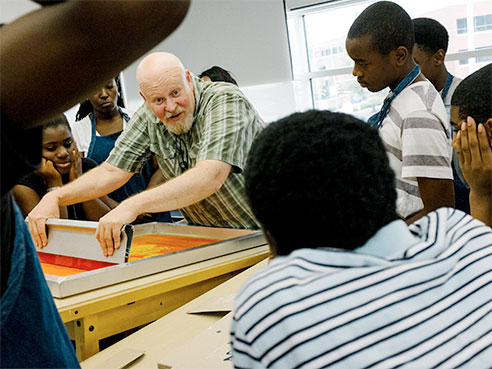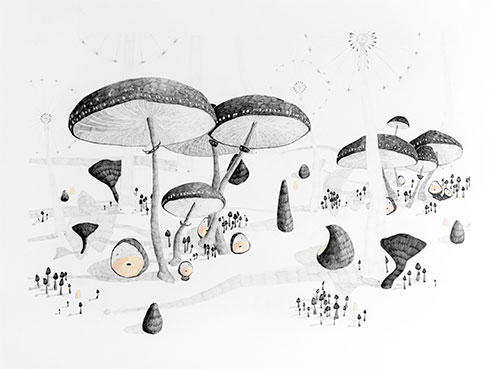 Associate Professor Doug Barrett leads a screen printing workshop with students from the Woodlawn High School Summer Bridge program, July 31, 2014, in the Department of Art and Art History Community Foundation of Birmingham Graphic Design Classroom in the Abroms-Engel Institute for the Visual Arts. Photo by Jared Ragland. University of Alabama at Birmingham students and faculty will join peers at a national conference to shape cities of the future.
Associate Professor Doug Barrett leads a screen printing workshop with students from the Woodlawn High School Summer Bridge program, July 31, 2014, in the Department of Art and Art History Community Foundation of Birmingham Graphic Design Classroom in the Abroms-Engel Institute for the Visual Arts. Photo by Jared Ragland. University of Alabama at Birmingham students and faculty will join peers at a national conference to shape cities of the future.
Two students and two professors from the Department of Art and Art History will represent UAB at the Alliance for the Arts in Research Universities 2015 Emerging Creatives Student Summit, PULSE: Creative Collaborations for Cities in Flux, Jan. 28-31, at Virginia Commonwealth University.
UAB is a founding member of the Alliance for the Arts in Research Universities (a2ru), and the summit is part of its national conference.
By the year 2030, approximately 81 percent of the world’s population will live in cities, according to estimates on the a2ru website, and this presents questions of paramount interest to modern-day thinkers.
At the summit, student teams — guided by experts, special guests and faculty mentors —will develop and present innovative project ideas that have the potential to alter urban life in the coming decades. Students may target housing, infrastructure, sustainability, social issues, economies, politics, energy, accessibility, security, design, health care, education, culture and other urban issues in local or global contexts. Students also will learn best practices for working with municipal leaders to implement ideas, projects and programs and build a national network of collaborators.
Attending are UAB Associate Professor Doug Barrett, MFA, and Assistant Professor Doug Baulos, MFA, with Bachelor of Fine Art students Anna Zoladz and Hannah Rettig. Barrett and Baulos, who embody this year’s conference theme, were chosen for their interdisciplinary work with students and innovative service and research in Birmingham.
 Region 3, 2014, by Anna Zoladz, Graphite and gouache on paper (22 in x 30 in) Robert Palazzo, Ph.D., Dean of the UAB College of Arts and Sciences, has championed a2ru and UAB’s involvement in it. Palazzo will attend and speak as part of a panel at the conference; he also is a member of the a2ru executive committee.
Region 3, 2014, by Anna Zoladz, Graphite and gouache on paper (22 in x 30 in) Robert Palazzo, Ph.D., Dean of the UAB College of Arts and Sciences, has championed a2ru and UAB’s involvement in it. Palazzo will attend and speak as part of a panel at the conference; he also is a member of the a2ru executive committee.
“As a founding member of a2ru, UAB takes the organization’s mission seriously, regularly integrating the arts into the vibrant, progressive research culture of our institution,” Palazzo said. “The cross-pollination of disciplines and practices at UAB, particularly within the College of Arts and Sciences, where our Department of Art and Art History is housed, has already led to innovative projects and opportunities for members of our diverse academic and civic communities.
“We are proud of our faculty and students who will be participating in this year’s conference,” Palazzo said. “Their work has earned them a place among prestigious participants, and their interests are as varied as the universities and people who partner with the organization. We look forward to seeing the results of what they learned at the conference in their future work and study.”
One of the missions of the DAAH is to support and emphasize the process of engagement in the community as a component of research, service and teaching, says Lauren Lake, MFA, chair of the Department of Art and Art History. Student and faculty participation at the conference supports this mission.
“The collaboration, dialogue and open exchange they have while in the field, as well as in the classroom at UAB, change the way people think about themselves and one another and ultimately contribute to sustainable change,” Lake said. “This active learning experience teaches students to be more empathetic and culturally competent members of communities.”
Baulos is education coordinator at Studio By the Tracks, and as the art education liaison between the Department of Art and Art History and the School of Education, he has led countless community-education projects across the country. Barrett’s Design for Good projects through students in his Bloom Studio include the Cahaba Blueway and Bibb County rebranding campaign and the Woodlawn community bus wrap, a competition won by Rettig.
Rettig says she is most interested in ways that cities can evoke a sense of community among their residents, especially “how a city can unite its inhabitants to create a cleaner, more productive, safer place.”
Zoladz is concerned about the technological needs of cities. The technological infrastructure of cities is becoming as important as the physical infrastructure, and if the digital networking begins to deteriorate, so do the political, social, economic and cultural networks, she says.
“I am very interested in the implications of having seamless, easily accessed Wi-Fi and how it can benefit a city’s population at an individual level and the population as a whole. Social networking, city-specific apps and other mobile technology that gathers city data are incredibly powerful in predicting problems and finding solutions that will shape cities for a more efficient future,” Zoladz said.
